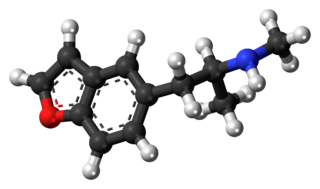
3,4-Methylenedioxymethamphetamine (MDMA), commonly known as ecstasy, and molly, is an empathogen–entactogenic drug with stimulant and minor psychedelic properties. In studies, it has been used alongside psychotherapy in the treatment of post-traumatic stress disorder (PTSD) and social anxiety in autism spectrum disorder. The purported pharmacological effects that may be prosocial include altered sensations, increased energy, empathy, and pleasure. When taken by mouth, effects begin in 30 to 45 minutes and last three to six hours.

3,4-Methylenedioxyamphetamine (MDA), sometimes referred to as sass, is an empathogen-entactogen, stimulant, and psychedelic drug of the amphetamine family that is encountered mainly as a recreational drug. In its pharmacology, MDA is a serotonin–norepinephrine–dopamine releasing agent (SNDRA). In most countries, the drug is a controlled substance and its possession and sale are illegal.

Methylone, also known as 3,4-methylenedioxy-N-methylcathinone (MDMC), is an empathogen and stimulant psychoactive drug. It is a member of the amphetamine, cathinone and methylenedioxyphenethylamine classes.

The substituted methylenedioxyphenethylamines represent a diverse chemical class of compounds derived from phenethylamines. This category encompasses numerous psychoactive substances with entactogenic, psychedelic, and/or stimulant properties, in addition to entheogens. These compounds find application as research chemicals, designer drugs, and recreational substances.

3,4-Methylenedioxyphentermine (MDPH) is a lesser-known drug of the amphetamine family. MDPH was first synthesized by Alexander Shulgin. Very little data exists about the pharmacological properties, metabolism, and toxicity of MDPH.

1,3-Benzodioxolylbutanamine is an entactogenic drug of the phenethylamine, amphetamine, and phenylisobutylamine families. It is the α-ethyl analog of MDPEA and MDA and the methylenedioxy analogue of α-ethylphenethylamine.

4'-Methoxy-α-pyrrolidinopropiophenone (MOPPP) is a stimulant designer drug of the pyrrolidinophenone class. It has the potential to produce euphoria, an effect shared with other classical stimulants.

MDAI, also known as 5,6-methylenedioxy-2-aminoindane, is an entactogen drug of the 2-aminoindane group which is related to MDMA and produces similar subjective effects.

α-Methyldopamine (α-Me-DA), also known as 3,4-dihydroxyamphetamine or as catecholamphetamine, is a research chemical of the catecholamine and amphetamine families. It is a monoamine releasing agent and a metabolite of MDMA and MDA. The bis-glutathionyl metabolite of α-methyldopamine is slightly neurotoxic when directly injected into the brain's ventricles.

6-(2-Aminopropyl)-2,3-dihydrobenzofuran is a stimulant and entactogen drug of the phenethylamine and amphetamine classes. It is an analogue of MDA where the heterocyclic 4-position oxygen from the 3,4-methylenedioxy ring has been replaced with a methylene bridge. 5-APDB (3-Desoxy-MDA) is an analogue of 6-APDB where the 3-position oxygen has been replaced with a methylene instead. 6-APDB, along with 5-APDB, was first synthesized by David E. Nichols in the early 1990s while investigating non-neurotoxic MDMA analogues.

MDMAT (6,7-methylenedioxy-N-methyl-2-aminotetralin) is a selective serotonin releasing agent (SSRA) and entactogen drug. It is the N-methylated derivative of MDAT, similarly to the relationship of MDMA to MDA. It has been theorized to have less long-term neurotoxicity and less hallucinogenic effects than other MDxx derivatives, but no formal scientific research has been conducted specifically on MDMAT.

6-Methyl-3,4-methylenedioxyamphetamine (6-Methyl-MDA) is an entactogen and psychedelic drug of the amphetamine class. It was first synthesized in the late 1990s by a team including David E. Nichols at Purdue University while investigating derivatives of 3,4-methylenedioxyamphetamine (MDA) and 3,4-methylenedioxy-N-methylamphetamine (MDMA).

3,4-Ethylidenedioxyamphetamine (EIDA) is a substituted derivative of 3,4-methylenedioxyamphetamine (MDA), which was developed by David Nichols and coworkers, in the course of research to determine the bulk tolerance around the benzodioxole portion of the MDA molecule. EIDA was found to produce similar effects to MDA in animals but with less than half the potency, while the isopropylidenedioxy derivative did not substitute for MDA and instead had sedative and convulsant effects. This shows limited bulk tolerance at this position and makes it likely the activity of EIDA will reside primarily in one enantiomer, although only the racemic mix has been studied as yet.

5-MAPB, also known as 5-(N-methyl-2-aminopropyl)benzofuran, is an entactogen and designer drug of the amphetamine family that is similar to MDMA in its structure and effects.

ODMA is a bioisosteric analogue of 3,4-methylenedioxy-N-methylamphetamine (MDMA) which was developed in an attempt to create an improved MDMA alternative for potential clinical use. It is the analogue of MDMA in which the 1,3-benzodioxole ring has been replaced with a 2,1,3-benzoxadiazole ring. TDMA and SeDMA are closely related analogues. ODMA, TDMA, and SeDMA are releasing agents of serotonin, norepinephrine, and dopamine similarly to MDMA. However, they are less potent and efficacious in activating the serotonin 5-HT2A, 5-HT2B, and 5-HT2C receptors than MDMA and show differing and potentially improved metabolic and pharmacokinetic properties in comparison. ODMA, TDMA, and SeDMA were first described in the scientific literature in June 2024.

TDMA is a bioisosteric analogue of 3,4-methylenedioxy-N-methylamphetamine (MDMA) which was developed in an attempt to create an improved MDMA alternative for potential clinical use. It is the analogue of MDMA in which the 1,3-benzodioxole ring has been replaced with a 2,1,3-benzothiadiazole ring. ODMA and SeDMA are closely related analogues. ODMA, TDMA, and SeDMA are releasing agents of serotonin, norepinephrine, and dopamine similarly to MDMA. However, they are less potent and efficacious in activating the serotonin 5-HT2A, 5-HT2B, and 5-HT2C receptors than MDMA and show differing and potentially improved metabolic and pharmacokinetic properties in comparison. ODMA, TDMA, and SeDMA were first described in the scientific literature in June 2024.

SeDMA is a bioisosteric analogue of 3,4-methylenedioxy-N-methylamphetamine (MDMA) which was developed in an attempt to create an improved MDMA alternative for potential clinical use. It is the analogue of MDMA in which the 1,3-benzodioxole ring has been replaced with a 2,1,3-benzoselenadiazole ring. ODMA and TDMA are closely related analogues. ODMA, TDMA, and SeDMA are releasing agents of serotonin, norepinephrine, and dopamine similarly to MDMA. However, they are less potent and efficacious in activating the serotonin 5-HT2A, 5-HT2B, and 5-HT2C receptors than MDMA and show differing and potentially improved metabolic and pharmacokinetic properties in comparison. ODMA, TDMA, and SeDMA were first described in the scientific literature in June 2024.

3,4-Dihydroxymethamphetamine, or 3,4-dihydroxy-N-methylamphetamine, also known as α-methylepinine or α,N-dimethyldopamine, is the major metabolite of 3,4-methylenedioxy-N-methylamphetamine (MDMA). It is formed from MDMA by O-demethylation via cytochrome P450 enzymes including CYP2D6 as well as CYP1A2 and CYP3A4. Like MDMA, HHMA is a monoamine releasing agent.

(R)-3,4-Methylenedioxy-N-methylamphetamine ((R)-MDMA), also known as (R)-midomafetamine or as levo-MDMA, is the (R)- or levorotatory (l-) enantiomer of 3,4-methylenedioxy-N-methylamphetamine (MDMA; midomafetamine; "ecstasy"), a racemic mixture of (R)-MDMA and (S)-MDMA. Like MDMA, (R)-MDMA is an entactogen or empathogen. It is taken by mouth.

4-Hydroxy-3-methoxyamphetamine (HMA), also known as 3-O-methyl-α-methyldopamine, is an active metabolite of 3,4-methylenedioxymethamphetamine (MDMA). It is substantially less potent than MDMA or 3,4-methylenedioxyamphetamine (MDA) as a monoamine releasing agent in vitro. Nonetheless, HMA has been found to induce the release of serotonin, norepinephrine, and dopamine with EC50Tooltip half-maximal effective concentration values of 897 nM, 694 nM, and 1450–3423 nM, respectively, and hence acts as a lower-potency serotonin–norepinephrine–dopamine releasing agent (SNDRA). The predicted log P of HMA is 0.6.




















